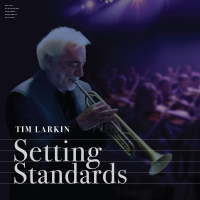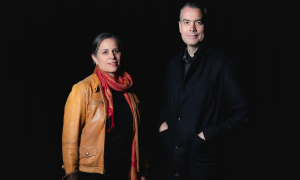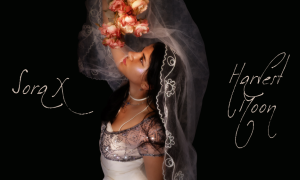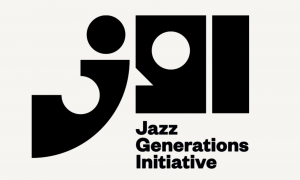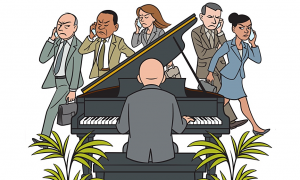In the summer of 1955, Candoli recorded two important quintet albums with Bill Holman that remain perfect examples of the influence. Yesterday, I spoke to Bill Holman about these dates and about Candoli. More in a moment.
In the mid-1950s, as East Coast record labels opened West Coast offices and new California-based labels emerged, recording opportunities expanded in Los Angeles, particularly for small groups. From an economic standpoint, the quartet, quintet and sextet were much more efficient than big bands, which required pricier studio set-ups, higher budgets and greater risk of costly re-takes and clock over-runs. Small groups also had young, marketable personalities while big band possibilities were lashed to aging leaders.
Record labels on the West Coast just needed seasoned players, and California had no shortage of young studio pros. Most had already honed their craft in the progressive instrumental big bands of the late 1940s and early 1950s, and many could record flawlessly. There was, however, a big shortage of West Coast musicians with distinct sounds. Perfection breeds similarity, and as recording possibilities for small groups increased in the mid-1950s, so did the search for individual players with an edge.
One the finest and best-regarded West Coast jazz trumpeters at the time was Conte Candoli. Born in Indiana, Candoli came up through the bands of Woody Herman, Chubby Jackson, Stan Kenton, Charlie Ventura and Charlie Barnet. By late 1954, Candoli was living fulltime in Los Angeles, and he recorded his first date that year as a leader, Sincerely Conte Candoli, for Bethlehem Records. [Pictured: Candoli, left, and guitarist Sal Salvador in the early 1950s]
In the summer of 1955, Candoli recorded a pair of 10-inch LPs with Bill Holman on tenor saxophone. The first, in July, was Conte Candoli, for Bethlehem. The second, in August, was West Coast Wailers, for Atlantic. The trio behind the duo was the same on both dates: Lou Levy on piano, Leroy Vinnegar on bass and Lawrence Marable on drums.
Both albums are available on one CD: Conte Candoli Quintet with Bill Holman and Lou Levy: Complete Recordings (Definitive). The CD is sensational, and the fidelity is fabulous. Candoli's warm but restless playing reflects the influences of a wide range of trumpet stars at the time, and the strength and deliberate style of Bill's saxophone is jaw-dropping. At times, it sounds like they're drag-racing on some asphalt strip out in the California desert.
I called Bill yesterday to ask him about Candoli and those 1955 sessions:
“We worked for a couple of months with that group. Everybody's chops were up for the dates. It was a nice band. I really enjoyed working with Conte. Count had a pretty dry sense of humor. He was very sincere and felt very deeply about music. I remember one night we were playing at this club, and someone walked out making a gesture like he was holding his nose. Conte handed his horn to me and took off after the guy, and made him apologize. [laughs] His attitude was, 'You don't mess with my band.' “ [Pictured: Candoli and Bill Holman]
On the Conte Candoli Quintet CD, you can hear the heated influence of Miles Davis and Clifford Brown on Candoli's playing. Which shouldn't come as much of a surprise. In 1953, Miles had appeared at Howard Rumsey's Lighthouse and was recorded there with Rolf Ericson (trumpet), Bud Shank (alto sax), Bob Cooper (tenor sax), Lorraine Geller (piano), Howard Rumsey (bass) and Max Roach (drums). And throughout the summer of 1954, Brown and Roach's hard bop group was in Los Angeles performing and recording. Any West Coast musician worth his salt either sat in with these artists at clubs or were listening in the audience.
Swept up by the more fiery East Coast attack, better West Coast jazz musicians began to develop a more urgent and personal sound. What emerged on the West Coast wasn't a knockoff but a hybrid--linear jazz with more bite.
Did Candoli adapt what Miles and Brown were doing at the time? Bill Holman continues:
“Conte was very influenced by the East Coast guys. Everybody that he liked rubbed off on him. He had stuff from Kenny Dorham, Dizzy, Miles and Clifford. Conte was not the most original player, but what he played, he really made it sound good. He could really get the feeling. All those guys are different, yet Conte could play their stuff, and it sounded real, from the heart.
“Compared to his brother, Pete [both pictured], Count was more of a jazz player. Pete was a great studio trumpet player but Conte was straight ahead jazz. We would always go to hear the East Coast guys who came through there. We kept abreast of who was playing what."
On the Conte Candoli Quintet CD, Bill is the perfect foil for Candoli. He's smooth, tough and confident, with Candoli showing off a full range of techniques. Candoli's staccato playing owed much to Miles and Dorham. But he also had plenty of Brown-like blowing power. The difference in all cases is that Candoli was a bit warmer around the edges.
Of the two albums on this CD, Conte Candoli showcases a variety of Candoli's trumpet styles, from Toots Sweet (Brown influence), Four (Miles), My Old Flame (Dorham) and Groovin' Higher (Dizzy). Bill's tenor playing will certainly take you by surprise. Most often heard during this period in big band settings, you get a chance to hear why he was such a creative force on the West Coast. He not only could write breathtaking arrangements but also could walk the walk.
West Coast Wailers includes several nifty tunes, including a Pete Candoli swinger called Pete's Alibi; Bill Holman's linear Cheremoya; and Jordu, the Duke Jordan standard that had already been recorded by Clifford Brown and Max Roach in Los Angeles in August 1954.
Perhaps the most inventive piece on the CD is Bill's arrangement of Flamingo, which includes a strong Clifford Brown-like reading by Candoli. Finally, there's the hard bop Marcia Lee, a Candoli tune with a faint Latin feel.
If you want to know what made Candoli special and hear Bill Holman up close and personal, this CD is a winner. You quickly realize that both of these musicians not only were exceptional instrumentalists but also perfect together. And vastly underrated as small-group monsters.
JazzWax tracks: Between the July and August dates when the two Candoli albums were recorded, the trumpeter recorded West Coast Jazz for Verve with tenor saxophonist Stan Getz as the leader along with Lou Levy (piano), Leroy Vinnegar (bass) and Shelly Manne (drums).
Compare Candoli's playing with Getz and Bill at the exact same period. The Verve date hits me as more East Coast visits the West Coast. By contrast, Candoli with Bill on the Definitive CD sounds much more relaxed, exhibiting more of the West Coast shift discussed earlier than complete abandonment. The best comparison tune is Four, which appears on both CDs.
This story appears courtesy of JazzWax by Marc Myers.
Copyright © 2025. All rights reserved.







